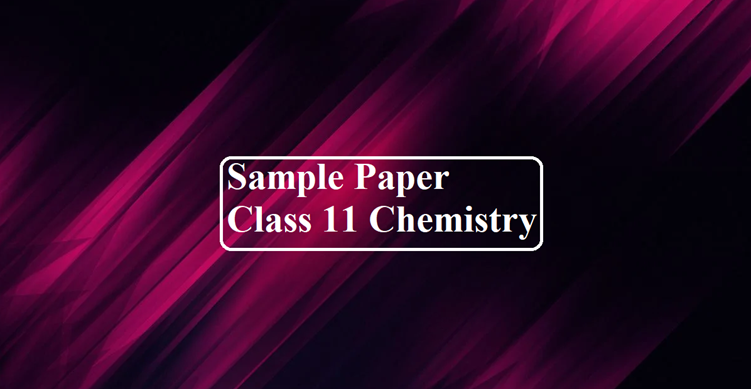Sample Paper Class 11 Chemistry
This post contains a detailed syllabus for Class XI Chemistry along with a Solved Sample Paper for session 2022-2023
CBSE Class 11 Chemistry Detailed Syllabus
Chapter I: Some Basic Concepts of Chemistry
General Introduction: Importance and scope of Chemistry. Nature of matter, laws of chemical combination, Dalton’s atomic theory: the concept of elements, atoms, and molecules. Atomic and molecular masses, mole concept and molar mass, percentage composition, empirical and molecular formula, chemical reactions, stoichiometry, and calculations based on stoichiometry.
Chapter III: Classification of Elements and Periodicity in Properties
Significance of classification, a brief history of the development of the periodic table, modern periodic law and the present form of the periodic table, periodic trends in properties of elements -atomic radii, ionic radii, inert gas radii, Ionization enthalpy, electron gain enthalpy, electronegativity, valency. Nomenclature of elements with atomic number greater than 100.
Chapter IV: Chemical Bonding and Molecular Structure
Valence electrons, ionic bond, covalent bond, bond parameters, Lewis’s structure, the polar character of covalent bond, the covalent character of ionic bond, valence bond theory, resonance, the geometry of covalent molecules, VSEPR theory, the concept of hybridization, involving s, p and d orbitals and shapes of some simple molecules, molecular orbital theory of homonuclear diatomic molecules (qualitative idea only), Hydrogen bond.
Sample Paper Class 11 Chemistry
Chapter V: Chemical Thermodynamics
Concepts of Systems and types of systems, surroundings, work, heat, energy, extensive and intensive properties, and state functions. The first law of thermodynamics -internal energy and enthalpy, heat capacity, and specific heat, measurement of ΔU and ΔH, Hess’s law of constant heat summation, enthalpy of bond dissociation, combustion, formation, atomization, sublimation, phase transition, ionization, solution, and dilution. Second law of Thermodynamics (brief introduction) Introduction of entropy as a state function, Gibb’s energy change for spontaneous and non-spontaneous processes, criteria for equilibrium. Third law of thermodynamics (brief introduction).
Chapter VI: Equilibrium
Equilibrium in physical and chemical processes, dynamic nature of equilibrium, the law of mass action, equilibrium constant, factors affecting equilibrium – Le Chatelier’s principle, ionic equilibrium- ionization of acids and bases, strong and weak electrolytes, degree of ionization, ionization of polybasic acids, acid strength, the concept of pH, hydrolysis of salts (elementary idea), buffer solution, Henderson Equation, solubility product, common ion effect (with illustrative examples).
Chapter VII: Redox Reactions
Concept of oxidation and reduction, redox reactions, oxidation number, balancing redox reactions, in terms of loss and gain of electrons and change in oxidation number, applications of redox reactions.
Chapter VIII: Organic Chemistry -Some Basic Principles and Techniques
General introduction, methods of purification, qualitative and quantitative analysis, classification, and IUPAC nomenclature of organic compounds. Electronic displacements in a covalent bond: inductive effect, electromeric effect, resonance, and hyperconjugation. Homolytic and heterolytic fission of a covalent bond: free radicals, carbocations, carbanions, electrophiles and nucleophiles, types of organic reactions.
Chapter IX: Hydrocarbons
Classification of Hydrocarbons:
Aliphatic Hydrocarbons:
Alkanes – Nomenclature, isomerism, conformation (ethane only), physical properties, chemical reactions including free radical mechanism of halogenation, combustion, and pyrolysis.
Alkenes – Nomenclature, the structure of double bond (ethene), geometrical isomerism, physical properties, methods of preparation, chemical reactions: addition of hydrogen, halogen, water, hydrogen halides (Markovnikov’s addition and peroxide effect), ozonolysis, oxidation, mechanism of electrophilic addition.
Alkynes – Nomenclature, the structure of triple bond (ethyne), physical properties, methods of preparation, chemical reactions: acidic character of alkynes, addition reaction of – hydrogen, halogens, hydrogen halides, and water.
Aromatic Hydrocarbons:
Introduction, IUPAC nomenclature, benzene: resonance, aromaticity, chemical properties: mechanism of electrophilic substitution. Nitration, sulphonation, halogenation, Friedel Craft’s alkylation and acylation, directive influence of the functional group in monosubstituted benzene. Carcinogenicity and toxicity.
Sample Paper Class 11 Chemistry
[pdfjs-viewer url=”https://sciencemotive.com/wp-content/uploads/2023/01/Solved-QP-Class-XI-1.pdf” attachment_id=”4694″ viewer_width=100% viewer_height=800px fullscreen=true download=true print=true]
Answer Key
[pdfjs-viewer url=”https://sciencemotive.com/wp-content/uploads/2023/01/ANSWER-KEY-CHEMISTRY-XI.pdf” attachment_id=”4698″ viewer_width=100% viewer_height=800px fullscreen=true download=true print=true]



